Finite Element Analysis of Combined Bearing Characteristics of Pile–Soil Interaction in Composite Foundation
Abstract
:1. Introduction
2. Theoretical Calculation of Additional Internal Forces in Composite Foundation Piles and Soil
- (1)
- Three-dimensional modeling of composite foundations: A three-dimensional finite element model of composite foundations was established by finely constructing three-dimensional numerical models of concrete piles, inter-pile soil, cushion layers, and lower rock–soil structures.
- (2)
- Calculation of initial ground stress field: The initial ground stress field of composite foundations was calculated through the finite element method by simulating the consolidation deformation of ground soil due to the self-weight stress before construction. At this time, concrete piles were assigned the material of the corresponding soil layer.
- (3)
- Loading condition calculation: Concrete material parameters were assigned to the concrete piles, and the vertical loads generated by the upper buildings on the surface of the composite foundations were applied to simulate the actual loading conditions of the composite foundations.
- (4)
- Calculation of additional internal forces of piles and soil: Based on the results of the three-dimensional finite element numerical calculations, the additional axial force on the cross-section of the target pile and the additional vertical force on the target soil were calculated. Then, the proportion of the additional axial force of the pile was calculated.
2.1. Assumptions
- (1)
- The pile bodies and soil were considered ideal linear–elastic materials and followed the Mohr–Coulomb yield criterion;
- (2)
- The soil layers were assumed to be uniformly distributed and isotropic, and the effects of soil voids and underground seepage were neglected;
- (3)
- The stress–strain behavior of the soil varied within the elastic–plastic range, while the pile bodies and cushion layers deformed elastically.
2.2. Method for Calculating the Additional Internal Forces of Target Piles and Soil
2.3. Calculation of the Proportion of Additional Axial Force in Piles
3. Three-Dimensional Finite Element Model of Composite Foundations
3.1. Project Overview
3.2. Finite Element Model
3.3. Loading Conditions and Material Parameters
4. Stress and Displacement Diffusion Laws of Pile Bodies and Soil in Composite Foundations with Different Types of Piles
4.1. Initial Stress Field of Composite Foundation
4.2. Stress Distribution
4.3. Displacement Distribution
5. Analysis of the Combined Load-Bearing Characteristics of Piles and Soil in Composite Foundations
5.1. The Variation in Additional Internal Forces on the Central Pile and Inter-Pile Soil along the Depth Direction
- (1)
- With an increase in the soil depth, the additional axial force on the central pile generally increased rapidly and then gradually decreased. In the depth range of 0 to 1/10 L, the cushion layer directly transmitted the pressure to the top of the pile, while the deformation of the inter-pile soil was greater than that of the pile, resulting in a rapid increase in the additional axial force on the pile. In the depth range of 1/10 L to 1 L, the vertical deformation of the pile was greater than that of the inter-pile soil, and the pile was subjected to the upward frictional force from the inter-pile soil, leading to a gradual decrease in the additional axial force on the pile. Compared with end-bearing friction piles, the additional axial force of the friction piles was smaller, and it increased with the pile modulus and decreased with the soil modulus. It is important to note that, within a depth range of 1 m from the top and bottom of the pile, there were significant variations in the additional internal forces acting on both the pile and the soil.
- (2)
- With an increasing depth into the soil, the additional vertical force acting on the soil between the piles underwent five distinct stages: a rapid decrease, a gradual decrease, constant maintenance, a gradual increase, and then a rapid increase. The cushion layer directly transferred pressure to the soil between the piles. Within a depth range of 1 m from the pile’s top, the additional vertical force acting on the soil between the piles decreased sharply due to the pile support. Within the depth range from 1 m to 0.1 L from the pile top, the additional vertical force decreased gradually. In the depth range of 0.1 L to 0.9 L, it remained relatively constant. Within the depth range from 0.9 L to 1 m from the pile bottom, the additional vertical force on the soil between the piles gradually increased. Starting from a depth of 1 m from the pile bottom, the additional vertical force on the soil between the piles increased rapidly.
- (3)
- Within a depth range of 1 m from both the top and bottom of the pile, the proportion of additional axial force on the central pile exhibited the most noticeable variation. Subsequently, it remained relatively constant within the depth range from 0.1 L to 0.9 L.
5.2. The Variation in the Additional Internal Forces on the Central Pile and Inter-Pile Soil along the Depth Direction
- (1)
- The additional vertical forces of the piles and inter-pile soil gradually decreased with an increasing soil depth, exhibiting an approximately linear relationship. This indicates that the load borne by the piles and inter-pile soil diminishes as a result of stress diffusion within the soil. Additionally, the additional vertical forces of the piles and inter-pile soil increased with an increase in the pile’s elastic modulus, but decreased with an increase in the soil’s elastic modulus. The additional vertical forces of the end-bearing friction piles were consistently greater than those of the friction piles, suggesting that end-bearing friction piles have a significant advantage in bearing top loads.
- (2)
- The ratio of the pile–soil additional vertical forces to the top load reflects the proportion of the top load borne by the piles and inter-pile soil. With an increasing soil depth, this ratio gradually decreased. For the friction piles, it decreased from 0.9–1.0 at the top to 0.20–0.35 at the bottom, while for the end-bearing friction piles, it decreased from 0.9–1.0 at the top to 0.7–0.85 at the bottom. This indicates that end-bearing piles experience more uniform loading, which is beneficial for enhancing the overall bearing capacity of the composite foundation.
- (3)
- Based on the slope of the curves, the additional vertical forces on all the piles and soil can be divided into three stages. Among these, the most significant changes occurred within a depth range of 1 m downwards from the pile’s top and 1 m upwards from the pile’s bottom. In this interval, the additional vertical force decreased linearly with an increasing depth. In comparison to the friction piles, the end-bearing piles exhibited a more gradual reduction trend. Increasing the pile stiffness effectively delayed the decrease in the additional vertical force, particularly when the pile stiffness increased to 25 GPa, where the additional vertical force remained essentially constant.
5.3. Discussion
- (1)
- Element type: Ref. [7] employed 20-node solid elements, while this study used 8-node solid elements. The difference in the displacement interpolation functions between the two types of elements arose from the incomplete quadratic polynomial interpolation functions of the 20-node elements, leading to certain computational errors.
- (2)
- Frictional resistance and end-bearing effect: In this study, the calculation considered the negative skin friction on the pile and the end-bearing effect. Contact elements were used to simulate the interaction between the pile and the soil, and the influence of the end-bearing effect when the pile bottom directly contacted the bedrock was also calculated.
6. Conclusions
- (1)
- The vertical stress of both the pile and the soil can be divided into three stages in the depth direction, from the pile’s top to the pile’s bottom. The stress diffusion of the pile undergoes a sharp increase, followed by a gradual decrease, and then a sharp decrease, while the stress diffusion of the soil is opposite to that of the pile.
- (2)
- The displacement of the pile can be divided by a critical depth. Above the critical depth, the displacement of the pile gradually decreases with depth, while below the critical depth, the displacement of the pile slightly increases with depth.
- (3)
- Under other identical conditions, end-bearing piles, due to their end-bearing effects and higher stiffness, exhibit larger vertical normal stresses and smaller deformations compared to friction piles, resulting in a higher bearing capacity for composite foundations.
- (4)
- The influence of the soil elastic modulus on the bearing characteristics of both the pile and the soil is very weak. In contrast, the bearing characteristics are mainly affected by the elastic modulus of the pile.
- (5)
- With an increase in soil depth, the stress diffusion effect of the soil becomes more pronounced. The additional vertical forces on all piles and inter-pile soil, as well as the ratio of additional vertical forces to the top load, gradually decrease. These trends are positively correlated with the elastic modulus of the pile and negatively correlated with the elastic modulus of the soil.
Author Contributions
Funding
Institutional Review Board Statement
Informed Consent Statement
Data Availability Statement
Conflicts of Interest
References
- Gong, X.; Chen, Z. Discussion on Some Key Issues Related to Foundation Engineering. Build. Struct. 2021, 51, 1–4. [Google Scholar] [CrossRef]
- Gong, X. Generalized Composite Foundation Theory and Engineering Application. Chin. J. Geotech. Eng. 2007, 29, 1–13. [Google Scholar]
- Guo, Z.X.; Huo, D. Computation of stress ratio of piles to soil and bearing behavior of rigid pile composite foundation. Rock Soil Mech. 2006, 27, 797–802. [Google Scholar] [CrossRef]
- Xu, Y. Establishment of Three Dimensional Composite Model and Its Application to Composite Foundation with Granular Piles. Chin. J. Rock Mech. Eng. 2004, 23, 3405–3412. [Google Scholar]
- Qiao, J.; Li, X. Numerical Analysis of Settlement of Composite Foundation and Natural Foundation under Earthquake Action. Earthq. Eng. Eng. Vib. 2006, 26, 245–247. [Google Scholar] [CrossRef]
- XU, Y.; Chen, G. Site Seismic Response Analysis of Composite Foundation Mixed with Cement Piles. J. Disaster Prev. Mitig. Eng. 2005, 25, 182–188. [Google Scholar]
- Chi, Y.; Song, E. Analysis of Bearing Performance of Rigid Pile Composite Foundation under Vertical Loads. Eng. Mech. 2003, 20, 9–14. [Google Scholar]
- Zhang, Y.; Pan, Z. Research on Mechanism and Dynamic Characteristics of Composite Foundation with Multi-Type Piles. China Earthq. Eng. J. 2015, 37, 82–87. [Google Scholar]
- Zhang, X.; Yu, D.; Zhu, K.; Zhao, A.; Ren, M. The Horizontal Bearing Characteristics and Microscopic Soil Deformation Mechanism of Pile-Bucket Composite Foundation in Sand. Appl. Sci. 2024, 14, 907. [Google Scholar] [CrossRef]
- Zhang, L.; Wang, T.; Zhao, Z.; Jin, X. Research on Bearing Difference between Single-Pile Composite Foundation Field Test and Group-Pile Composite Foundation of High-Rise Buildings. Buildings 2023, 13, 2127. [Google Scholar] [CrossRef]
- Zhao, M.; Long, J. Comparative Analysis of Model Tests on Different Types of Composite Foundations. Chin. J. Geotech. Eng. 2013, 35, 611–618. [Google Scholar]
- Guo, Y.; Lv, C.; Hou, S.; Liu, Y. Experimental Study on the Pile-Soil Synergistic Mechanism of Composite Foundation with Rigid Long and Short Piles. Math. Probl. Eng. 2021, 2021, 6657116. [Google Scholar] [CrossRef]
- Dai, G.; Feng, S. Experimental Study on Bearing Performance of Caisson-Cushionpiles Composite Foundation Under Low Cyclic Loading. China J. Highw. Transp. 2022, 35, 142–153. [Google Scholar] [CrossRef]
- Li, L.; Ye, J. Experimental Study on Bearing Characteristics of Nodular Pile Composite Foundation in Soft Soil Area. Chin. J. Undergr. Space Eng. 2020, 16, 986–992. [Google Scholar]
- Wang, C.; Zeng, F.; Gao, S.; Yuan, G. Experimental Study on Reinforcement of Marine Clay by Artificial Hard Shell Layer Composite Foundation. Mar. Georesour. Geotechnol. 2023, 41, 1393–1403. [Google Scholar] [CrossRef]
- Yu, J.; Zhou, J.; Gong, X.; Xu, R.; Li, J.; Xu, S. Centrifuge Study on Behavior of Rigid Pile Composite Foundation under Embankment in Soft Soil. Acta Geotech. 2021, 16, 1909–1921. [Google Scholar] [CrossRef]
- Wu, M.; Liu, B.; Xie, Y.; Ning, D. The Feasibility Study on Treating Soft-Soil with Lightweight-Pile Composite Foundation. Integr. Ferroelectr. 2019, 199, 30–45. [Google Scholar] [CrossRef]
- Zhu, K.; Wei, G.; Xu, R. Research on in-situ tests of pile load transfer behaviors in composite foundation with rigid- flexible piles. Rock Soil Mech. 2009, 30, 201–205+210. [Google Scholar] [CrossRef]
- Ding, X.; Zhang, T.; Li, P.; Cheng, K. A Theoretical Analysis of the Bearing Performance of Vertically Loaded Large-Diameter Pipe Pile Groups. J. Ocean Univ. China 2016, 15, 57–68. [Google Scholar] [CrossRef]
- Sulaiman Al-Ne’aimi, R.M.; Hussain, M.S. Numerical Modeling and Parametric Study of Piled Rafts Foundations. Arab. J. Geosci. 2021, 14, 447. [Google Scholar] [CrossRef]
- Li, L.; Zhang, P.; Long, Q. Design scheme of variable stiffness leveling of pile group in typical soft soil stratum. J. Railw. Sci. Eng. 2022, 19, 1288–1297. [Google Scholar] [CrossRef]
- Zhang, G.; Zhang, J. Relationship between pile-soil composite foundation bearing capacity and replacement rate of sluice. Eng. J. Wuhan Univ. 2013, 46, 328–333. [Google Scholar]
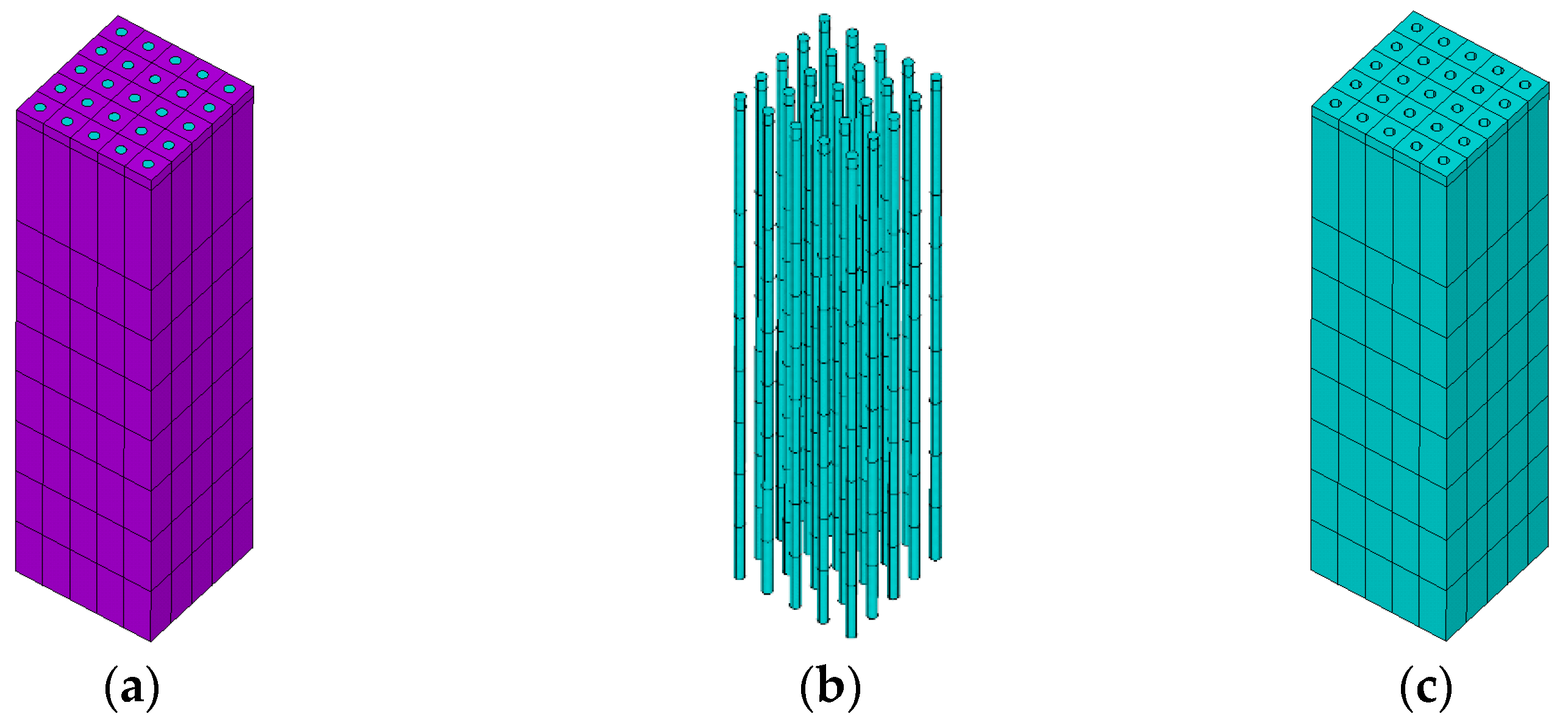

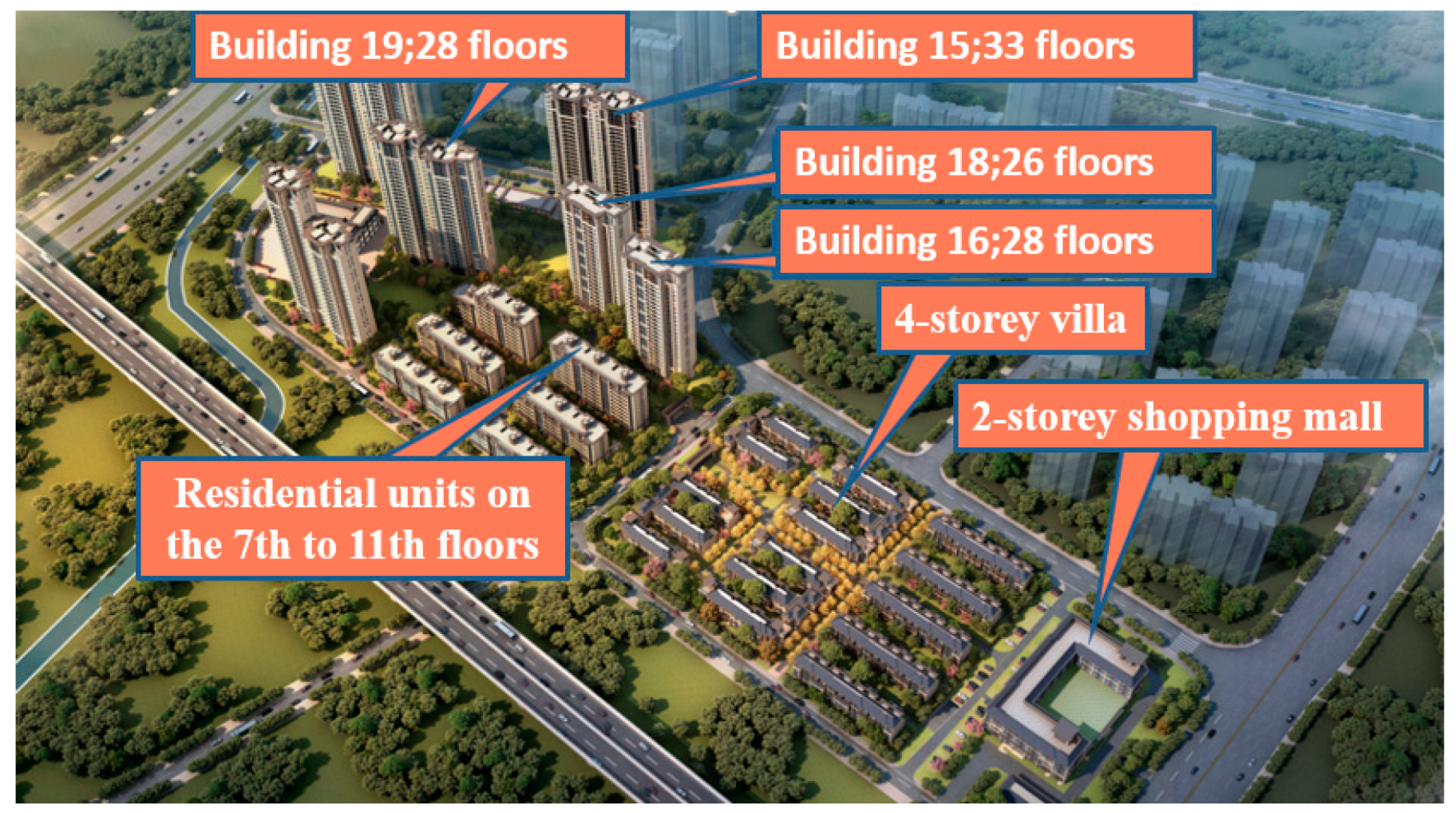
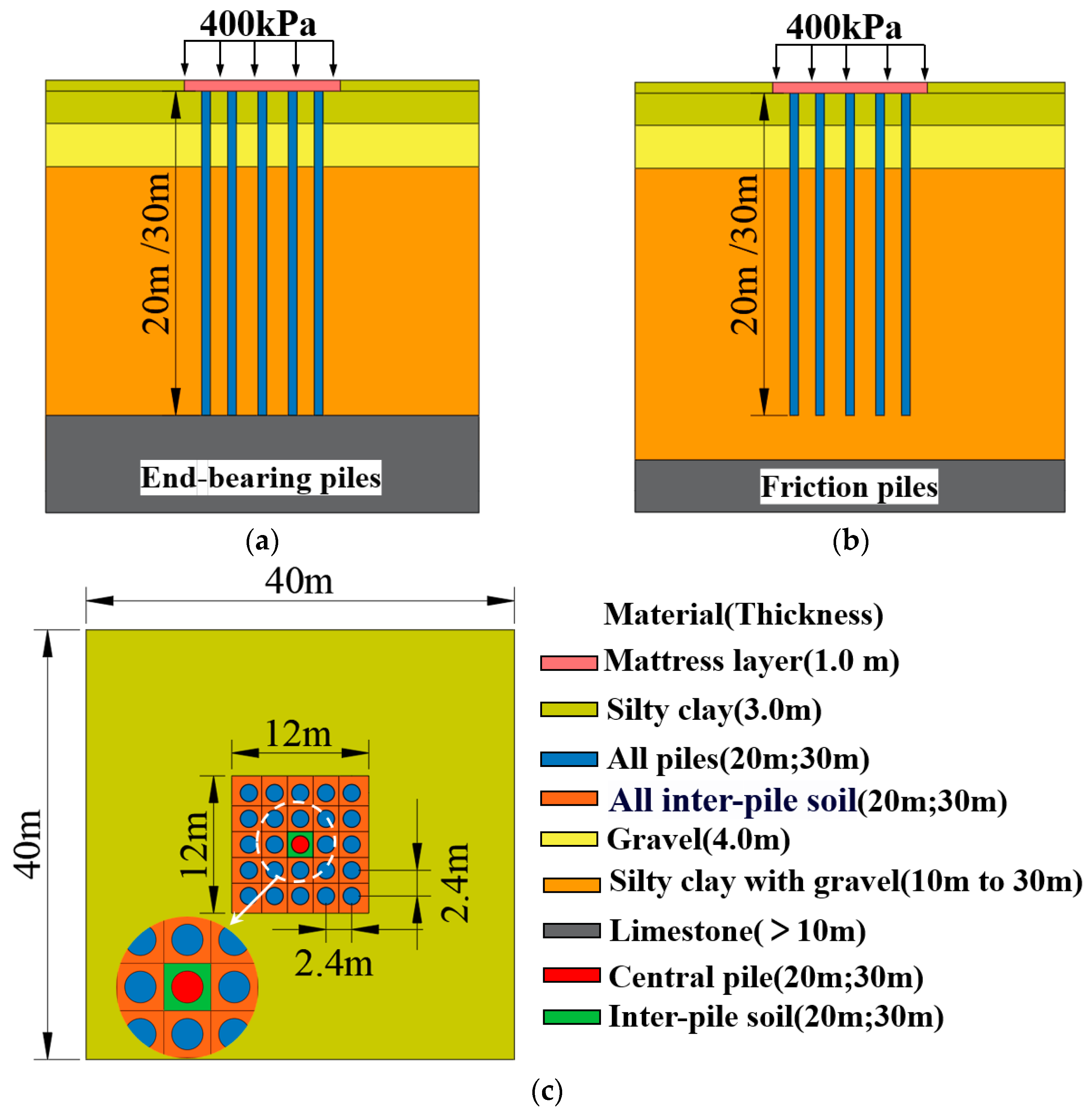
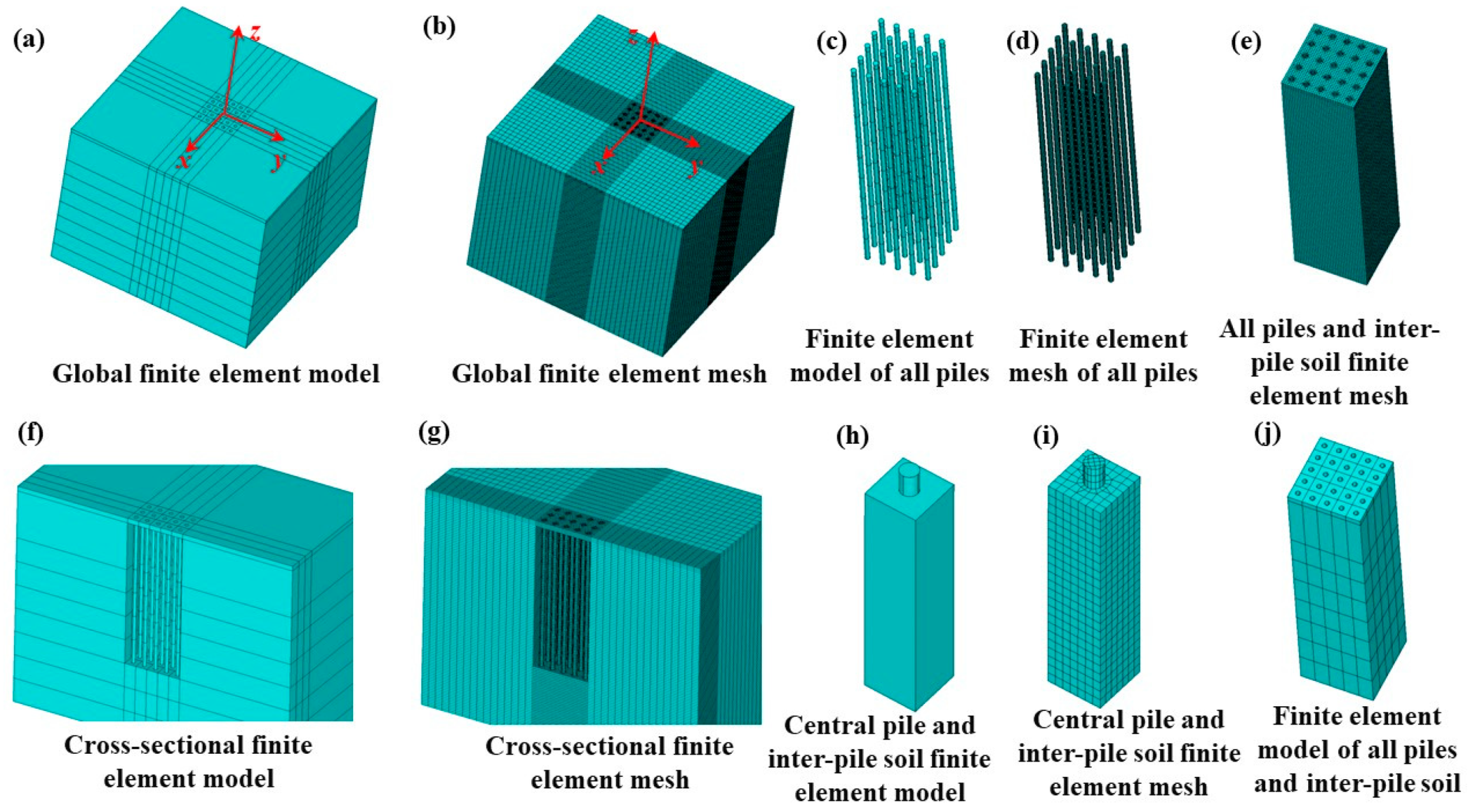

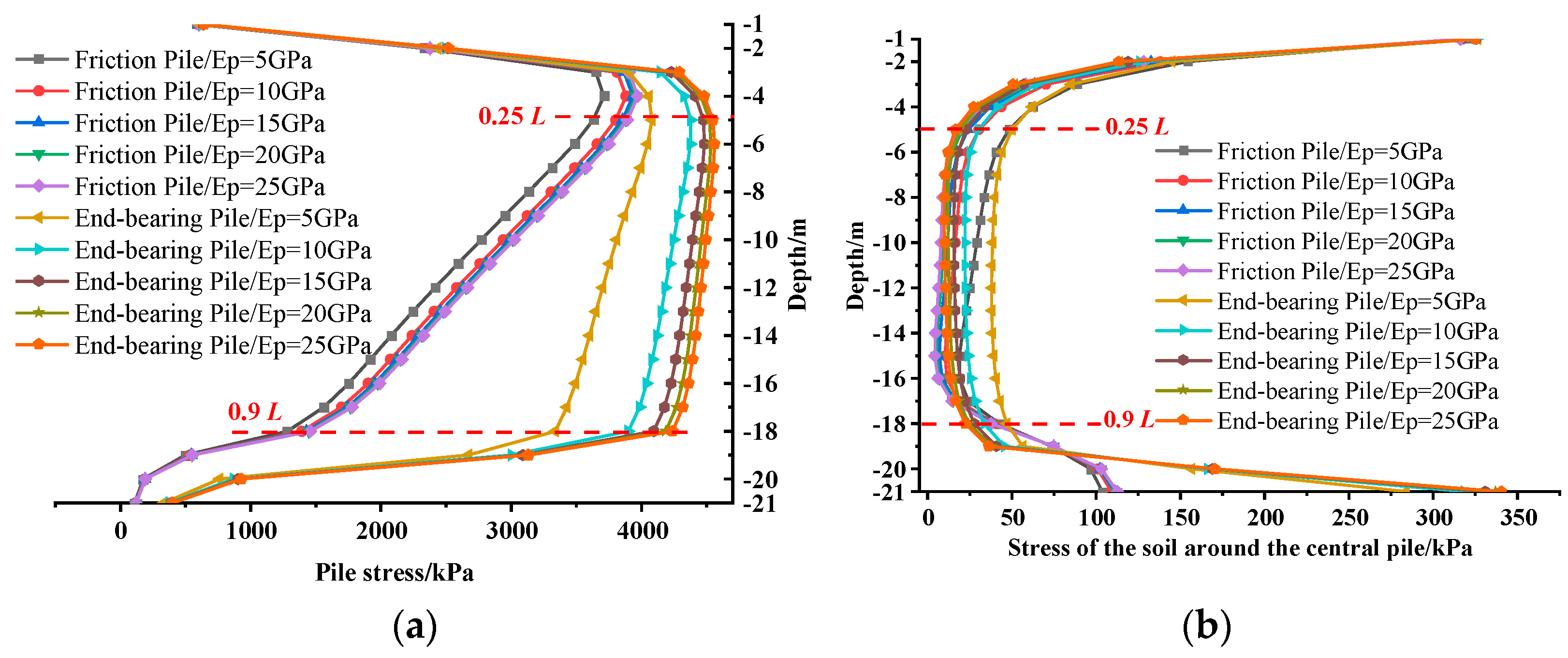


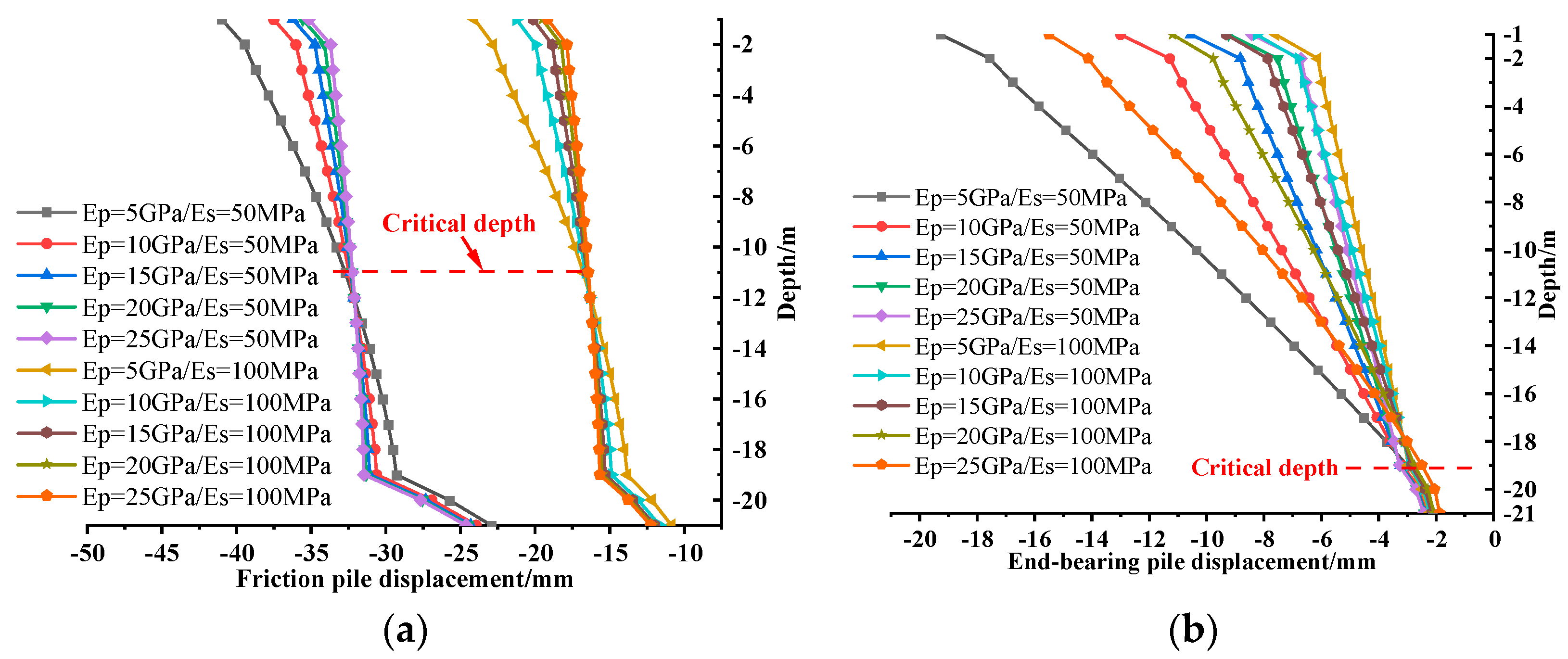
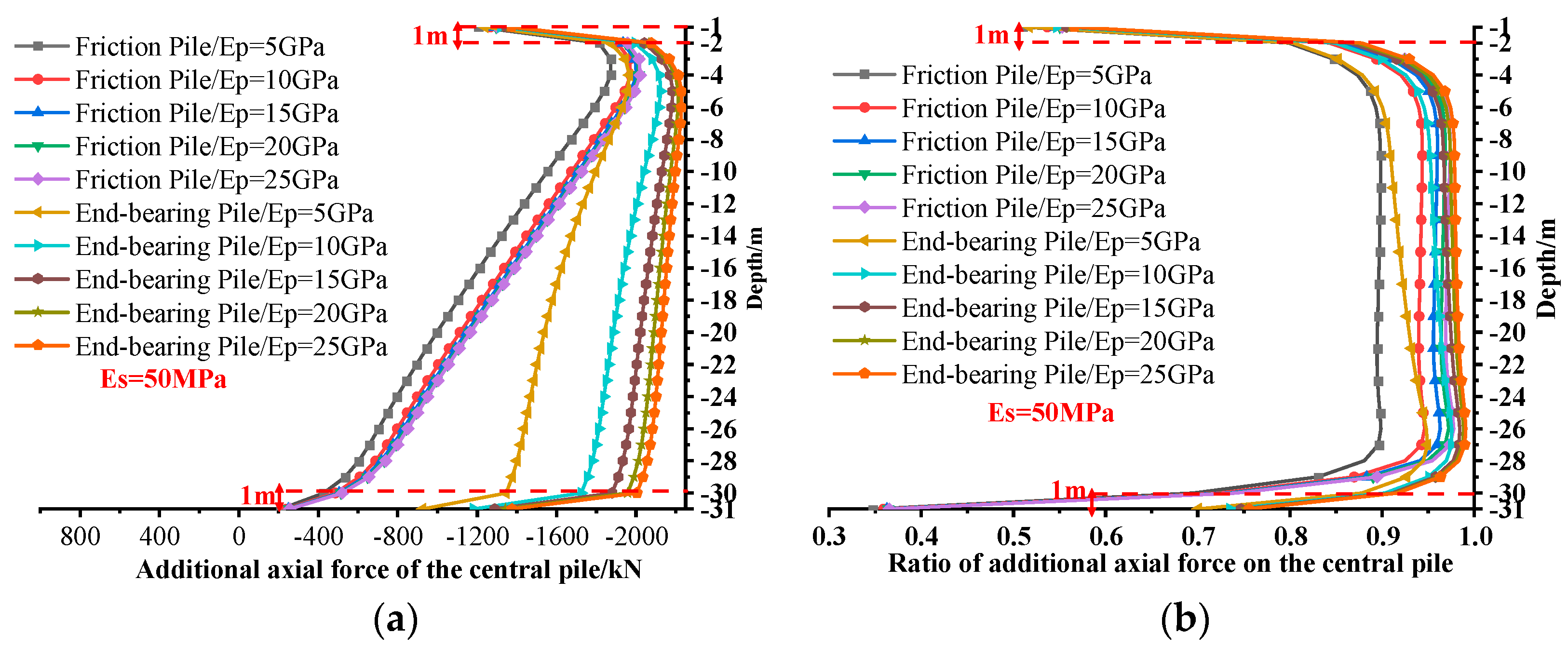

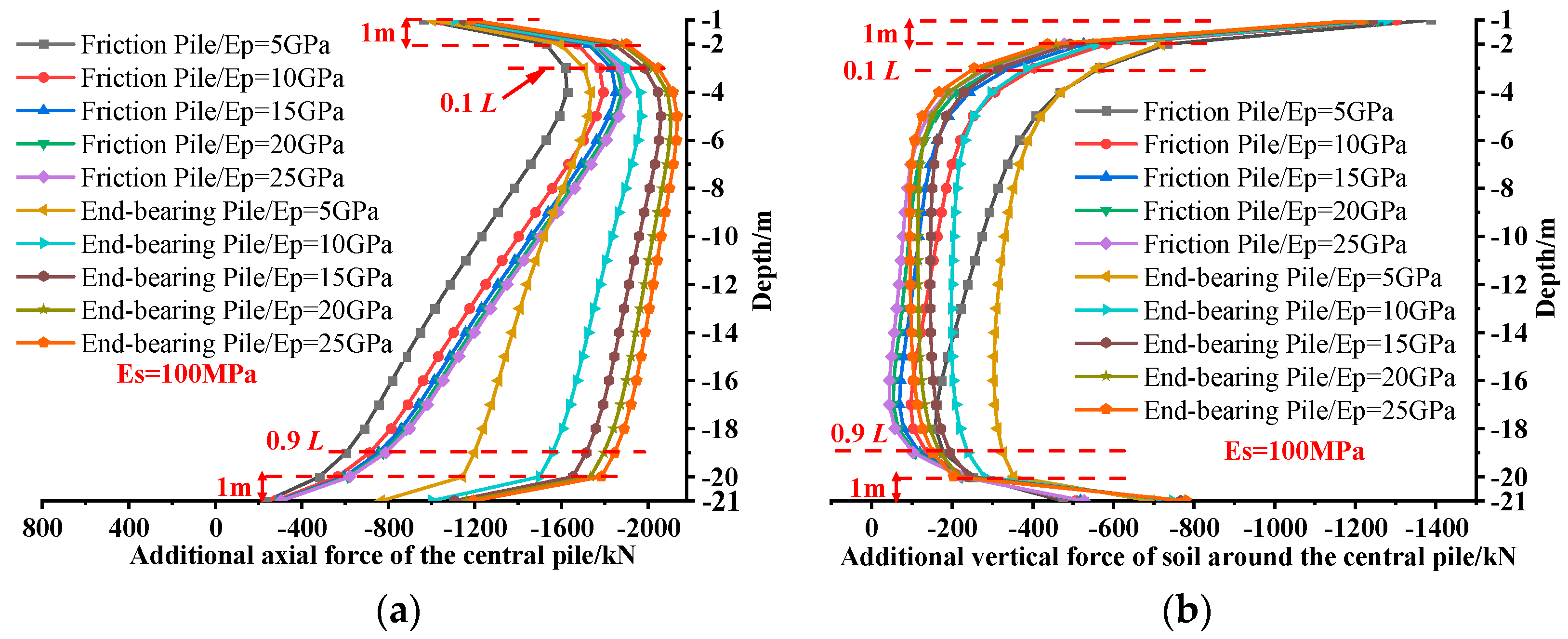

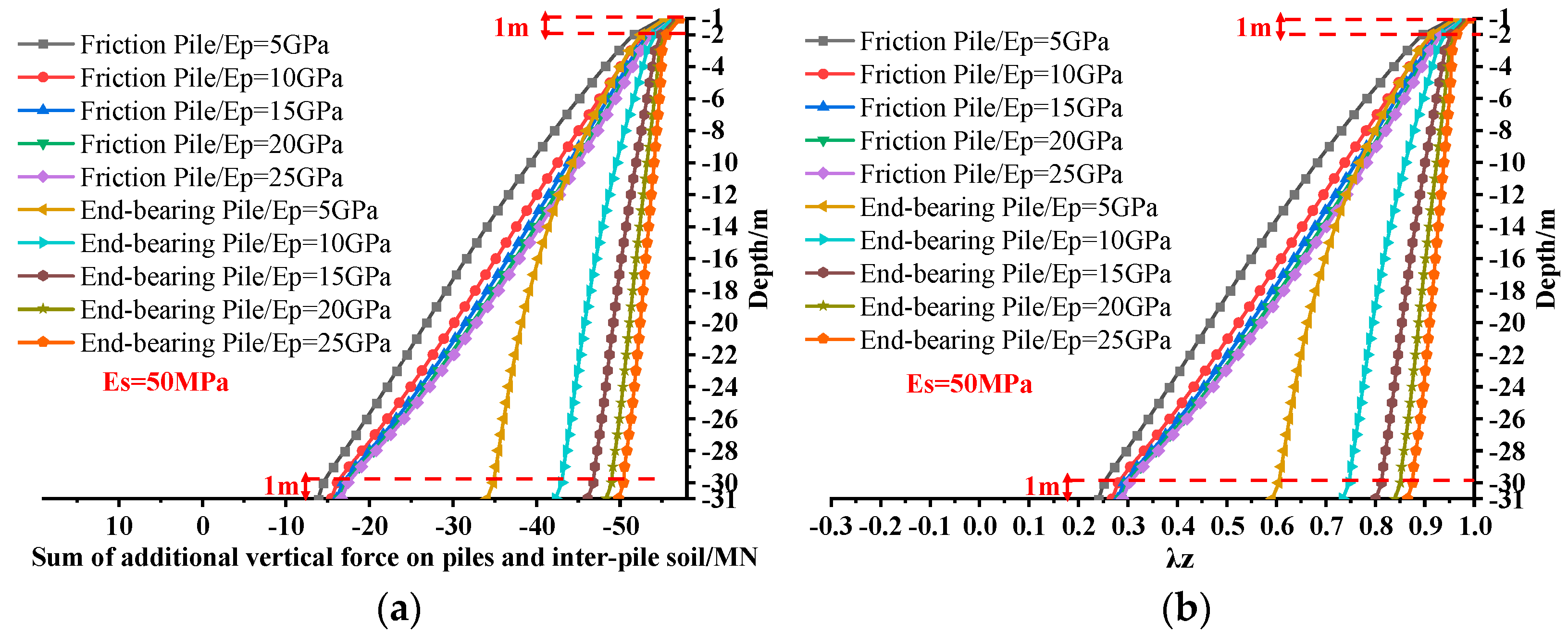

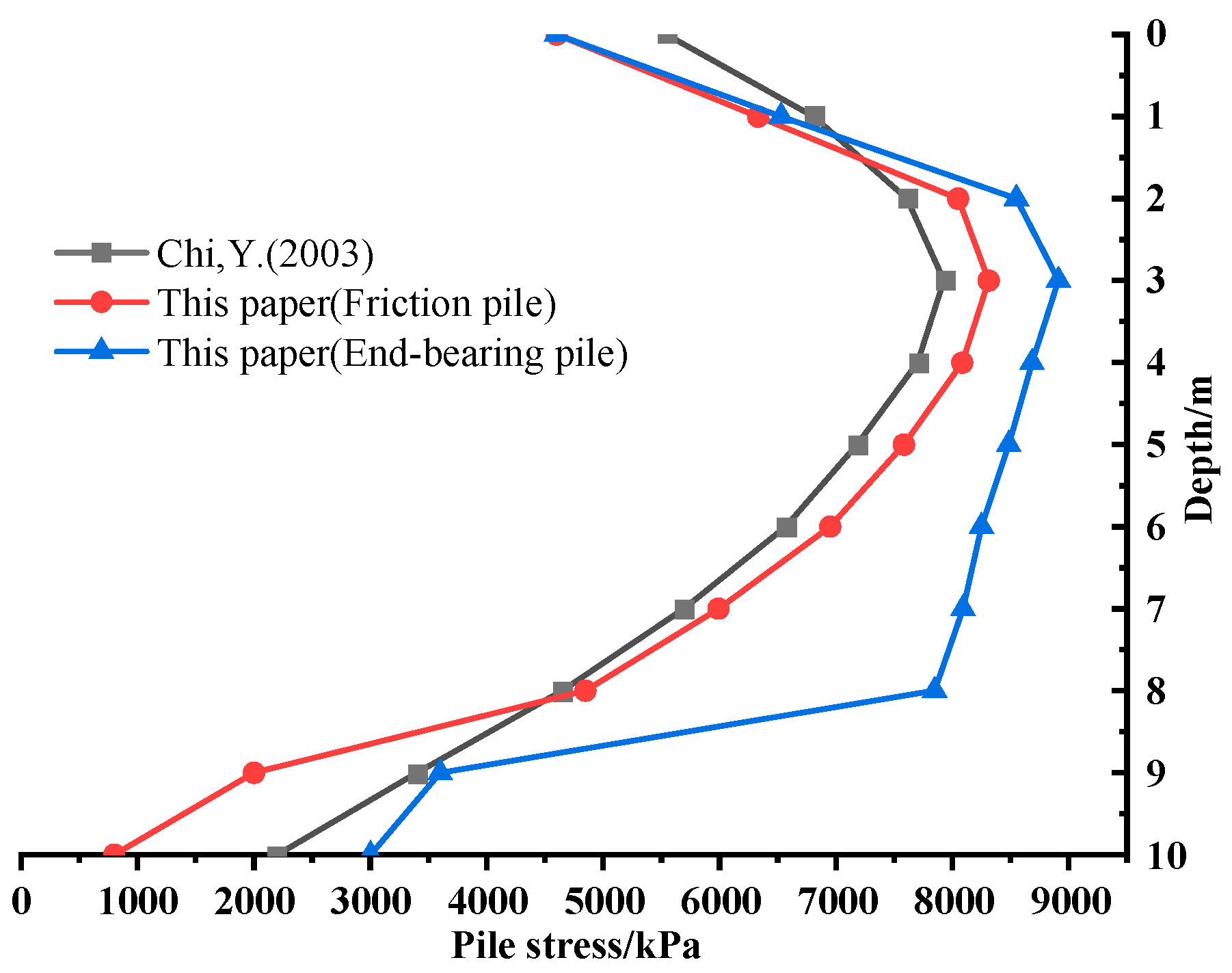
| Serial Number | Material Type | Thickness of Soil Layer/m | Density/kg/m3 | Elastic Modulus/MPa | Poisson’s Ratio |
|---|---|---|---|---|---|
| 1 | Mattress layer | 1.0 | 2100 | 100 | 0.30 |
| 2 | Silty clay | 3.0 | 1900 | 20 | 0.32 |
| 3 | Gravel | 4.0 | 2200 | 80 | 0.28 |
| 4 | Angular gravelly silty clay | 10.0~30 | 1800 | 50 | 0.32 |
| 5 | Limestone | 12.0 | 2400 | 2000 | 0.28 |
| 6 | Pile | 20.0; 30.0 | 2400 | 5000~25,000 | 0.27 |
| Pile Length L/m | Soil Elastic Modulus Es/MPa | Concrete Pile Elastic Modulus Ep/MPa | Pile Type |
|---|---|---|---|
| 20; 30 | 50; 100 | 5000; 10,000; 15,000; 20,000; 25,000 | Friction pile; end-bearing friction pile |
| Parameters | Comparison of Conditions | Ratio of Additional Vertical Force to Top Load λt/λb | Increase in the Ratio λ, Denoted as Δλt/Δλb | |
|---|---|---|---|---|
| Pile length L | 20 m | Friction piles Ep = 5 GPa Es = 50 MPa | 0.953/0.298 | 0.363%/−19.364% |
| 30 m | 0.956/0.241 | |||
| Soil elastic modulus Es | 50 MPa | Friction piles Ep = 5 GPa L = 20 m | 0.953/0.298 | −1.610%/−8.708% |
| 100 MPa | 0.938/0.272 | |||
| Pile elastic modulus Ep | 5 GPa | End-bearing friction piles Es = 50 MPa L = 20 m | 0.965/0.696 | 1.565%/ 13.023% |
| 10 GPa | 0.980/0.800 | |||
| Pile type | Friction piles | L = 20 m Ep = 5 GPa Es = 50 MPa | 0.953/0.298 | 1.222%/133.277% |
| End-bearing friction piles | 0.965/0.696 | |||
Disclaimer/Publisher’s Note: The statements, opinions and data contained in all publications are solely those of the individual author(s) and contributor(s) and not of MDPI and/or the editor(s). MDPI and/or the editor(s) disclaim responsibility for any injury to people or property resulting from any ideas, methods, instructions or products referred to in the content. |
© 2024 by the authors. Licensee MDPI, Basel, Switzerland. This article is an open access article distributed under the terms and conditions of the Creative Commons Attribution (CC BY) license (https://creativecommons.org/licenses/by/4.0/).
Share and Cite
Sui, S.; Zhang, X.; Lu, K.; Li, Z.; Liu, W.; Xu, H.; Han, P. Finite Element Analysis of Combined Bearing Characteristics of Pile–Soil Interaction in Composite Foundation. Appl. Sci. 2024, 14, 3894. https://doi.org/10.3390/app14093894
Sui S, Zhang X, Lu K, Li Z, Liu W, Xu H, Han P. Finite Element Analysis of Combined Bearing Characteristics of Pile–Soil Interaction in Composite Foundation. Applied Sciences. 2024; 14(9):3894. https://doi.org/10.3390/app14093894
Chicago/Turabian StyleSui, Sugang, Xiaoyan Zhang, Kaiyu Lu, Ze Li, Wenlian Liu, Hanhua Xu, and Pengwei Han. 2024. "Finite Element Analysis of Combined Bearing Characteristics of Pile–Soil Interaction in Composite Foundation" Applied Sciences 14, no. 9: 3894. https://doi.org/10.3390/app14093894





